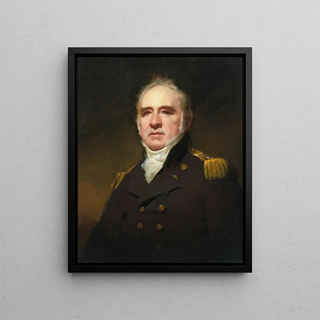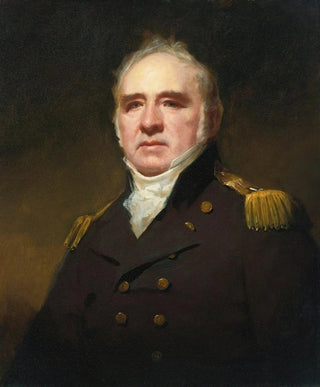Art print | Portrait of Captain James Forbes Drummond, R. N. of Hawthornden - Sir Henry Raeburn


View from behind

Frame (optional)
In the vast panorama of 18th-century British art, the "Art print of Captain James Forbes Drummond, R. N. of Hawthornden" stands out as an emblematic work by Sir Henry Raeburn. This painting does not merely capture the image of a man in naval uniform; it also evokes an era rich in history and social change. Captain Drummond, a prominent figure of his time, is immortalized in a pose that combines dignity and humanity. Through this portrait, Raeburn invites us to explore the nuances of his subject's personality while immersing us in the subtleties of the art of painting.
Style and uniqueness of the work
Raeburn's style is often characterized by his masterful use of light and shadow, creating an atmosphere that is both realistic and romantic. In this portrait, the play of light highlights the features of Captain Drummond, emphasizing the depth of his gaze and the texture of his uniform. The artist manages to establish an emotional connection between the subject and the viewer, transcending the simple exercise of representation. The rich colors and meticulous details, such as reflections on the golden buttons and the folds of fabric, demonstrate Raeburn's technical mastery. Every element of the painting seems carefully chosen to contribute to the overall, making this work a true ode to the personality of the captain and to the art of portraiture.
The artist and his influence
Sir Henry Raeburn, born in Scotland in 1756, is recognized as one of the greatest portraitists of his era. His ability to capture the essence of his subjects made him an essential figure in the art world. Influenced by the masters of Flemish and Italian painting, Raeburn developed a style that is uniquely his own, blending realism and expressiveness. His portraits, often commissioned by aristocracy and the bourgeoisie, reflect a time when personal and social identity was emphasized. Raeburn not only shaped British portraiture but also inspired many artists across generations, contributing

Matte finish

View from behind

Frame (optional)
In the vast panorama of 18th-century British art, the "Art print of Captain James Forbes Drummond, R. N. of Hawthornden" stands out as an emblematic work by Sir Henry Raeburn. This painting does not merely capture the image of a man in naval uniform; it also evokes an era rich in history and social change. Captain Drummond, a prominent figure of his time, is immortalized in a pose that combines dignity and humanity. Through this portrait, Raeburn invites us to explore the nuances of his subject's personality while immersing us in the subtleties of the art of painting.
Style and uniqueness of the work
Raeburn's style is often characterized by his masterful use of light and shadow, creating an atmosphere that is both realistic and romantic. In this portrait, the play of light highlights the features of Captain Drummond, emphasizing the depth of his gaze and the texture of his uniform. The artist manages to establish an emotional connection between the subject and the viewer, transcending the simple exercise of representation. The rich colors and meticulous details, such as reflections on the golden buttons and the folds of fabric, demonstrate Raeburn's technical mastery. Every element of the painting seems carefully chosen to contribute to the overall, making this work a true ode to the personality of the captain and to the art of portraiture.
The artist and his influence
Sir Henry Raeburn, born in Scotland in 1756, is recognized as one of the greatest portraitists of his era. His ability to capture the essence of his subjects made him an essential figure in the art world. Influenced by the masters of Flemish and Italian painting, Raeburn developed a style that is uniquely his own, blending realism and expressiveness. His portraits, often commissioned by aristocracy and the bourgeoisie, reflect a time when personal and social identity was emphasized. Raeburn not only shaped British portraiture but also inspired many artists across generations, contributing






